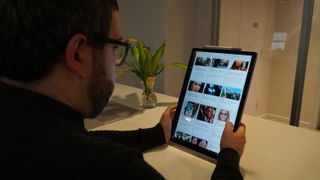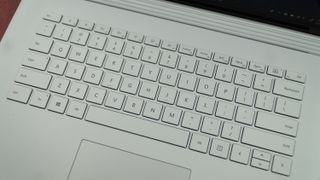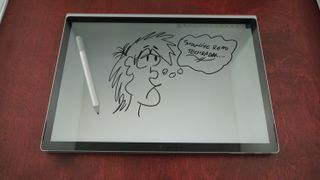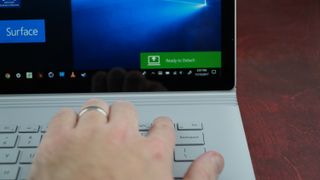Microsoft Surface Book 2 (15-inch)
the best for gaming
Microsoft Surface Book 2 (15 inch) deals
Compare Deals
Amazon Deals
Indisputably better than the first, the Surface Book 2 remains as one of our favorite 2-in-1 laptops you can buy today. However, it’s not as lonely in our rankings as it once was. As Microsoft eagerly makes a continued effort to best Apple’s MacBook Pro, there’s now a model with a 15-inch screen in addition to the usual 13.5-inch variant. It aims to be the end-all and be-all laptop that suitably replaces all of your other devices, but does it succeed?
Unfortunately, the answer to that rhetorical question isn’t as obvious as it would seem. Sure, the Surface Book 2 makes a dent within the confines of the laptop space, but does it serve as an equally refined tablet? And, what’s more, do its specs compete on an even playing field with some of the more powerful desktops you can buy or build? Those are but some of the questions we’ve asked ourselves in the making of this full-length review of the Surface Book 2.
Luckily, for most people, the Surface Book 2 can realistically replace your other hardware. It’s more powerful and portable than ever, so to speak. But, it’s also an expensive proposition, one that’s bound to be deemed inaccessible by the vast majority of the population. So, before we get started with its design and features, let’s take a look at the Surface Book 2’s cost.
Spec Sheet
Here is the configuration for the Microsoft Surface Book 2 (15-inch) configuration sent to TechRadar for review:
CPU: 1.9GHz Intel Core i7-8650U (quad-core, 8MB cache, up to 4.2GHz with Turbo Boost)
Graphics: Intel UHD Graphics 620; Nvidia GeForce GTX 1060 (6GB GDDR5 VRAM)
RAM: 16GB LPDDR3 (1866Mhz)
Screen: 15-inch, 3,240 x 2,160 (260 ppi) PixelSense display (3:2 aspect ratio; 1600:1 contrast ratio)
Storage: 1TB PCIe 3.0 SSD
Ports: 2 x USB 3.1, 1 x USB 3.1 Type-C, 2 x Surface Connect, SD card reader, 3.5mm audio jack
Connectivity: 802.11ac 2 x 2 MIMO Wi-Fi, Bluetooth 4.1, Xbox Wireless
Camera: Windows 8MP rear-facing autofocus camera (1080p), 5MP front-facing Hello face-authentication camera (1080p HD)
Weight: 4.2 pounds (1.9kg) with keyboard base
Size: 13.5 x 9.87 x 0.568 ~ 0.90 inches (343 x 251 x 15 ~ 23mm; W x D x H)
Graphics: Intel UHD Graphics 620; Nvidia GeForce GTX 1060 (6GB GDDR5 VRAM)
RAM: 16GB LPDDR3 (1866Mhz)
Screen: 15-inch, 3,240 x 2,160 (260 ppi) PixelSense display (3:2 aspect ratio; 1600:1 contrast ratio)
Storage: 1TB PCIe 3.0 SSD
Ports: 2 x USB 3.1, 1 x USB 3.1 Type-C, 2 x Surface Connect, SD card reader, 3.5mm audio jack
Connectivity: 802.11ac 2 x 2 MIMO Wi-Fi, Bluetooth 4.1, Xbox Wireless
Camera: Windows 8MP rear-facing autofocus camera (1080p), 5MP front-facing Hello face-authentication camera (1080p HD)
Weight: 4.2 pounds (1.9kg) with keyboard base
Size: 13.5 x 9.87 x 0.568 ~ 0.90 inches (343 x 251 x 15 ~ 23mm; W x D x H)
Price and availability
Surprising no one, the 15-inch Surface Book 2 is a hugely expensive laptop, with the configuration we’ve tested coming in at a crazy $3,299 in the US. Naturally, this is the highest end that the Surface Book 2 gets, with the entry-level model starting at a still-steep $2,499 (£2,349, AU$3,649) – its only difference being a much smaller 256GB solid-state drive (SSD) inside.
In the UK, the larger Surface Book 2 can be configured with twice the storage of the 256GB model for £2,749, or with a 1TB SSD for £3,149. Meanwhile, in Australia, the 512GB Surface Book 2 is $4,249, whereas the 1TB version sells for $4,849 including GST.
The 13.5-inch Surface Book 2, on the other hand, now starts at a rather economical $1,199 (around £850, AU$1,500) in the US, with other countries likely to follow in the footsteps of this surprising price cut. It unfortunately doesn’t come without compromise either, as this cheapest flavor of the Surface Book 2 you can buy is limited to just 128GB of storage space, alongside a dual-core Intel Core i5 processor and 8GB of RAM.
Keep in mind that none of these prices include Microsoft’s $99 (£99, AU$139) Surface Pen. And yes, we will continue to call Microsoft out on this until it begins bundling this nigh-crucial accessory in with the price of its Surface devices again.
For comparison’s sake, Apple’s 15-inch MacBook Pro with Touch Bar starts at $2,399 (£2,349, AU$3,499) for a 7th-generation Intel Core i7 processor an AMD Radeon Pro 555 graphics chip with 2GB of VRAM, 16GB of memory and a 256GB SSD – all powering a 2,880 x 1,800-pixel 15.4-inch display at 220 pixels per inch as well as an OLED Touch Bar.
For another 100 bucks, you’re getting a more up-to-date processor and far stronger graphics powering a sharper display with touch control that detaches and acts as a tablet. Not accounting for personal taste, it’s tough to dispute that the Surface Book 2 is the better value here.

Design
It’s no understatement to say that, from a look and feel perspective, Microsoft simply took the original Surface Book and blew it up in all dimensions to make the Surface Book 2 a 15-inch device in all its brushed aluminum splendor. While Microsoft clearly put a lot of effort in vastly increasing the laptop’s power profile and screen technology, this is, in many ways, simply a bigger Surface Book.
That’s not necessarily a bad thing, mind you. Microsoft has clearly taken what it had learned from the Surface Book i7 and went to town with it, crafting a power-packed 15-inch laptop that’s actually rather light. Better yet, when detached from its base, this is the lightest-feeling 15-inch tablet we’ve ever tested – to the point that it feels deceptively small in our hands.
That said, the Surface Book 2’s fulcrum hinge does make for a laptop that’s a little more unwieldy to cram into a backpack than most, and it’s now more pronounced than ever. Worse still, Microsoft didn’t do much design-wise with the extra space that 15 inches affords you.
For instance, the glass trackpad isn’t quite as wide or deep as, say, the 15-inch MacBook Pro’s when it very well could have been, given the space. Also, the lack of up-firing stereo speakers in the base is a glaring omission, with ample space on all three remaining sides of the keyboard for extra audio chambers.

Instead, we’re stuck with rather tinny, albeit front-firing, speakers on the tablet portion of the device. The bigger keyboard base should offer us bigger everything, frankly, not just bigger graphics. Worse yet is that the audio jack is still in the same weird, upper-right-edge position it’s always been, dangling over our hands and distracting us while typing.
Speaking of which, typing on the Surface Book 2 is a pleasure, with a brightly backlit keyboard that demonstrates deep-enough travel and punchy feedback. However, in our view, the feedback could stand to be a touch more forceful – but that could be down to personal taste.
All told, we like the Surface Book 2 (15-inch) design quite a bit – even its 1080p webcam and rear camera should impress at the next meeting or in your Instagram feed. But, we can’t ignore the missed opportunities to refine the product that much further and make the experience that much bigger when it comes to how it feels, looks and sounds.

Display and Surface Pen
Of course, we’re just as in love with the Surface Book 2 (15-inch) display as we were with the previous two models. Text looks crisp on the screen as do photos and video, even if the 3:2 aspect ratio makes for some awfully thick black bars during the latter.
The display’s resolution is nigh-unmatched short of 4K laptops, and Apple’s MacBook displays can’t hold a candle to it pixel for pixel. While Apple’s P3 color gamut might tower over Microsoft’s panel in the eyes of art and media pros, we don’t see much difference between the two in regards to color reproduction.
We’re told that Microsoft devoted quite a bit of effort to improving the touch response in its latest PixelSense display for the Surface Book 2, and it shows in testing. If any lag between drawing on the screen with the Surface Pen and its appearance on the screen was there before, it’s certainly imperceptible now.

In fact, if you scribble on a sticky note and run the Surface Pen off of the note window – you’ll see traces of ink appear on whatever is there, though it will almost immediately disappear. That’s a special processor rendering the ink before even Windows 10 does, we’re told, which should speak to the absence of latency in the touchscreen.
Plus, attaching and detaching the display from the keyboard base is as speedy as you’d expect from a wildly expensive computing device. Whether it’s going into tablet mode or back into a laptop, it’s less than a second before you’re successfully tapping or typing away.
At any rate, the Surface Book 2 screen goes to show that Microsoft can craft displays worthy of comparison against the technology world’s greatest in basically every metric.






Commentaires
Enregistrer un commentaire